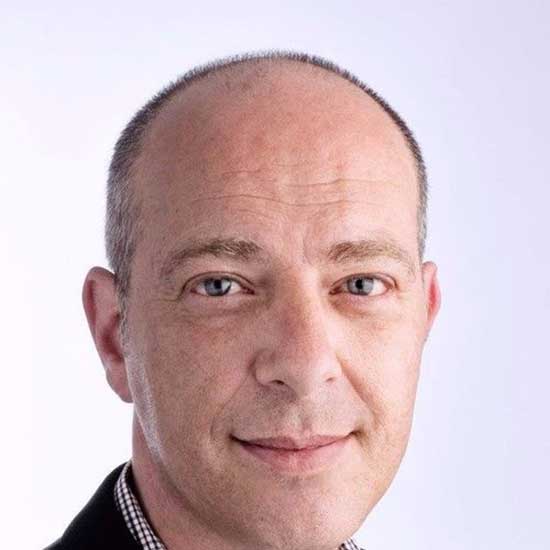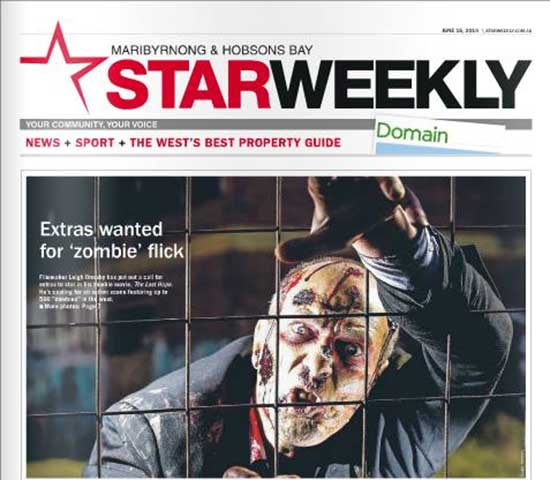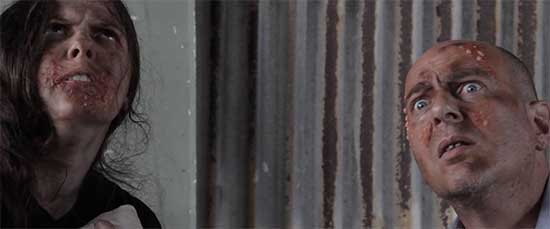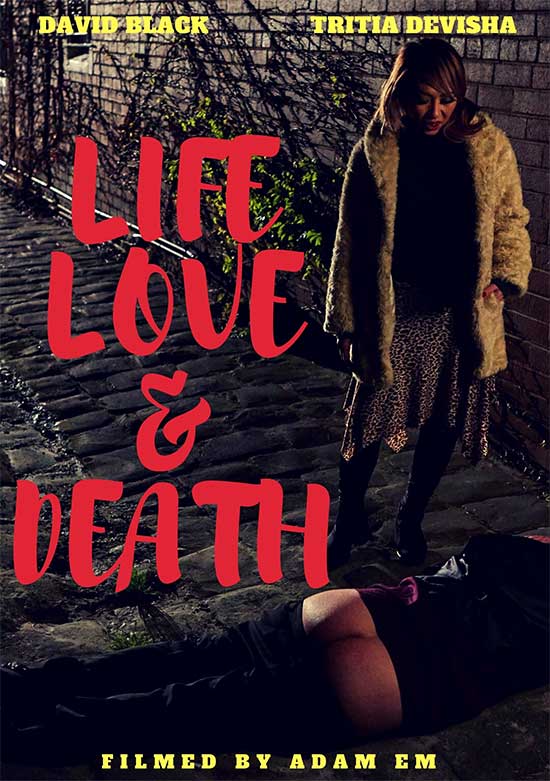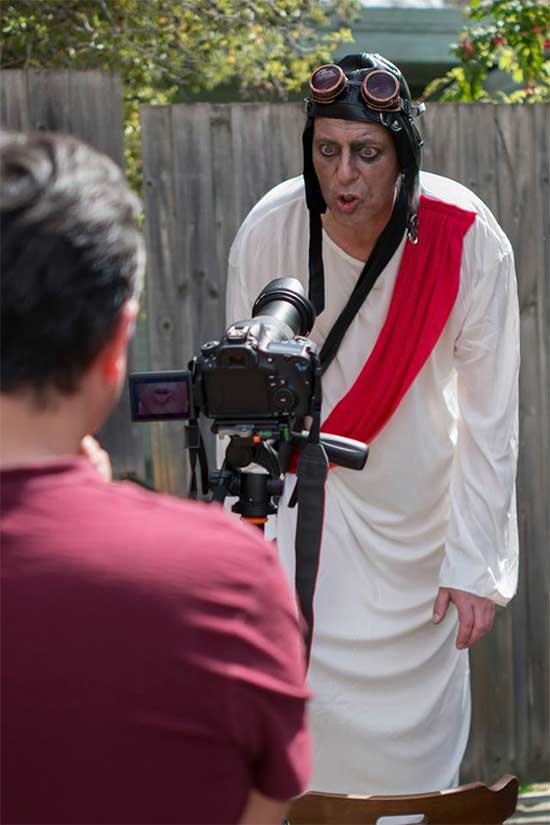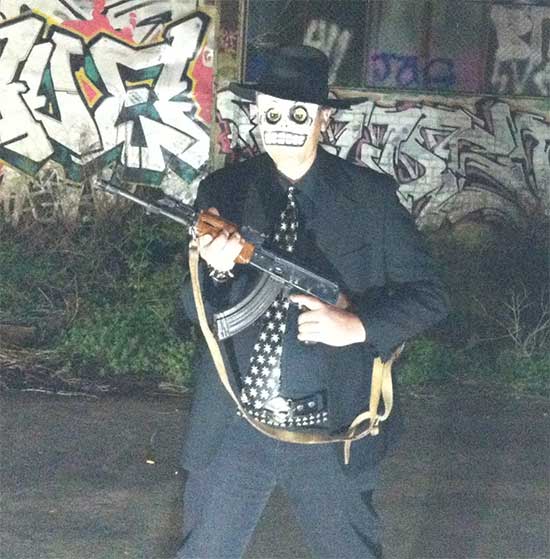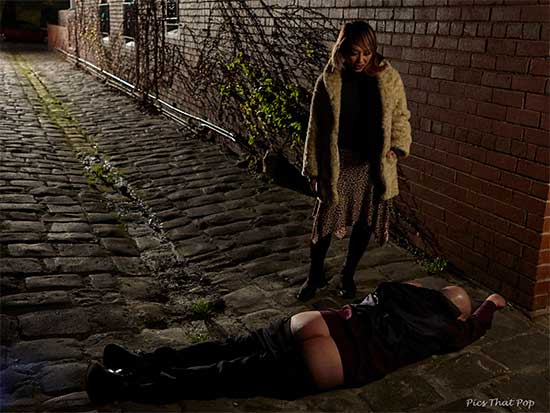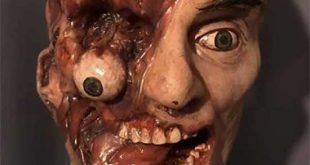I like to think that my cinema interests have grown in variety over the years to embrace more output from different countries as well as varying sizes of budget and notoriety (both the pictures that enjoy multi-airings over a month as well as one that you might see once every 3 years and, even then, at 3:30am on a Saturday morning from a station about 100 miles away from you but you have basic cable so….). Maybe some of it had to do with my Dad always having on the creature feature show with that ubiquitous badly dubbed Euro B going on. That’s kind of how I came to know the works of Mario Bava, Riccardo Freda, Dario Argento and others.
You can insert helmers from a few other countries as well (Kurosawa, Inoshiro Honda, Harald Reinl to name but a few). I became hooked on the films produced in Australia right around 1984 or 85 when I first viewed Russell Mulcahy’s brilliantly visceral monster show Razorback. It had everything from quiet suspense to full-throttle shock. Didn’t hurt the gay man in me that it had Gregory Harrison as the imported American star but that’s a tale for another day. With the locations used and the style of film that it showed me (all refreshingly new for this burgeoning horror and movie fan), I wanted to see as much more of down under output as I could get my hands on. What followed was Picnic at Hanging Rock, Turkey Shoot and a host of other gems that chilled my marrow. As with any passion, this one grew and morphed along with my cinema obsession as a whole to want to see more in indie works as much as the majors. It was that desire that recently put me into the orbit of David Black, a young Australian maverick auteur on the cusp of great things. We’d connected officially through social media and I had a chance to see the no budget, bitingly funny short Cannibal Barbecue. Essentially a middle America community gets conned into thinking a street barbecue vending operation is for charity when it’s really testing out a humans-as-delicacy menu on unsuspecting folk. I researched quite a bit about Mr. Black and found that his stock is skyrocketing in the digital market these days. I was both overjoyed and honored that he agreed to an interview. Without further blood, I mean, adieu……
KN: Thank you, David, for agreeing to this interview. My interest in film was almost born into me as I was about 5 years old when I first recall catching my dad watching classic films and horror films on our Admiral 19 inch tv back in the early 70s. I was literally transfixed at that point. Did you come about a passion for filmmaking in a similar fashion, growing up in Melbourne, Australia? I understand from my research of you that you had interests in arts, crafts, music and theatre while in school.
DB: Hi Kevin, thanks for taking the time to chat to me. I think I was just a touch older when I started watching old Horror Movies on our b&w PYE TV. I was around 7 when I first saw a hosted horror show called Deadly Earnest which featured The Outer Limits. Channel 0 also used to have horror movies all night on Friday 13, starting with the 1930’s Universal classics, then moving to the Hammer House of Horror films. I’m not sure what happened after that because I was just a kid and would fall asleep by midnight. With school, I was lucky that I was able to do quite a bit from year 7 – 9. Art, craft and music were curriculum subjects. I also joined the choir and was in the stage plays. Most Sundays, I would ride my bike the whole 15 km to get to rehearsals. I changed schools for years 10 & 11 and the best that the new one offered was a course called Film & TV Appreciation. Interestingly, they had us watch a few Dario Argento movies, so that was a real eye opener. My previous school had been a private one and would have suspended me for even having any gory horror movie paraphernalia, so having his films as part of the curriculum was mind blowing.
KN: You would go on to be in a punk band called Thrush at 17 and, later, with Darkness Visible where you did some videos. I have a feeling you had had the drive to do film before this but was this the final impetus you needed to get into film making officially?
DB: Definitely. I helped make a film as part of Film and TV appreciation when I was at school around 1981. That was the old days where things were on reels and editing was done by hand. My favourite memory with that one was an electronic explosion we had so that our laser gun looked like it had a bit of oomph! In 1984, a filmmaker from Geelong shot a full gig of my band Thrush. That footage is going to be seen in an upcoming documentary called the Hardcore History of Punk. I didn’t have much to do with the production side of this and am grateful that someone went to all that trouble. I think it was shot on VHS. Later, around 1990, I got some filming done by a friend that was shooting survivor testimonies for the Holocaust Museum via the Steven Spielberg Project. This gave her access to equipment. The footage was shot on Beta, but the colour balancing was out and there was a lot of stuffing around with having to play the tape on various machines to fix it. Trying to book time to use all this different equipment at various studios was time consuming and involved a lot of travel. Making copies to submit to the tv stations itself was going to be expensive. It all became too difficult and the film was never finished. My friend just gave up and the project died. I’d been the editorial cartoonist for a national tabloid newspaper called The Truth and was hoping to break into TV. It was a show where I sat at the desk and drew an editorial cartoon while discussing the politics behind it and some of the ideas behind the drawing. Nowadays, that sort of approach to storytelling is free online with explainer video apps where you see a cartoon being drawn. It’s amazing how the difficulty levels with some things years ago was overwhelming but is now doable with just the click of a button. I had one more shot at film few years later, around 1995, when trying to create a music video for Darkness Visible. I’d been interviewed on camera by a university film student, who brought out a 10 minute documentary on the local gothic scene. He used the band’s music for it and the end product was nicely cut but I didn’t follow up to get him to do that music video because the band’s lineup was falling apart. The timing just wasn’t right.
I didn’t manage my first music video until around 2008, when we filmed the first Darkness Visible music video, Flesh, on mini dv. With the digital age, I was able to get started properly in film making. I’d re-started the band with a new lineup, after a break of more than ten years, and one of the first things we did was get a music video happening. Everything now became possible for me because you could film and edit digitally, internet speeds having increased sufficiently to get things out around the world. It wasn’t necessarily affordable for the average joe at first, so my next few music videos were shot by university students who had access to their school’s cameras and editing suites. The price of equipment has now come down so all of the film makers I work with own their own gear.
KN: I’ve had a lifelong love affair with Australian film in any genre, from Breaker Morant to Gallipoli (Peter Weir is in the master class of directors, in my opinion) to the brilliant Picnic at Hanging Rock. Are there any films, either in-country or internationally, that inspired/inspire you to become a filmer?
DB: The golden age of Ozploitation was where my love of Aussie cinema started. These movies were proudly Australian. They often had a larrikin feel about them and I was influenced by the attitude of snubbing one’s nose at authority. Films like Breaker Morant, Picnic at Hanging Rock and Gallipoli were favourites but didn’t influence me greatly. They seemed a bit mainstream. It was more the off-the-wall films like Mad Max, Turkey Shoot and Dead End Drive-In that set my imagination on fire.
KN: What draws you to the horror genre in particular? Is it a chance to live out your imagination as it were?
DB: My biggest love is actually sci-fi and fantasy. I started my movie-making with horror as it was a natural step after being in a theatrical horror rock band. I’ve made other types of movies. However most of the opportunities available at the indie level are in this genre. I’ve done 3 short sci-fi movies and they’ve been well received, but when it comes to what people are demanding … horror is it!
KN: I’ve interviewed many a filmmaker who has completely embraced multi-tasking in handling a project. For some, notably the young indie helmers, it was simply practical. They didn’t have a lot of money to hire all the crew a major studio has so they just did it themselves. But there is another side of it that I recall Luigi Cozzi telling me once. That the best education on making movies that he got was on a film set (starting as a gaffer and working his way up) rather than at the university. Is that your approach as well?
DB: On the multi-tasking side, I was already doing my own makeup, creating props, scripting up skits and working on costumes for Darkness Visible. There was a smooth transition from stage show to music video to short films, so the question of multi-tasking in relation to filmmaking never really came up for me personally. It’s different for newcomers to my sets, though. When we start filming, a lot of the cast and crew find themselves doing multiple jobs. I might have the soundie and gaffer come in as extras and even got the BTS photographer to do a voice over once. In relation as to whether the on-set experience is better than university training is something that I can’t answer. I didn’t go to film school whereas many of the crew on my sets did. Quite a few have their diplomas in cinematography, so I’m often drawing on their film school training. I think that in most endeavors, schooling gives you the basics but getting out there and experiencing reality completes it.
KN: I’ve read and heard all the usual cons with making pictures for the internet market: that it’s frustrating to find funding and gain a notoriety mainly. But I see that the positives are really beginning to outweigh the negatives by some margin these days. Distribution is far more widespread, more major studios and online entities (such as Amazon and Netflix) are getting involved and looking for artists, and the festival circuit is really spreading names and reputations. What’s your take on the plusses and minuses of the internet and film?
DB: We’ve moved from a time when production was extremely expensive and channels were very few, to a time where anyone with a phone can make a film and the outlets are never ending. In the old days, if you approached the few TV stations that were around and they said no, then that was it. Now, no one can stop you getting your films out. There are heaps of VOD sites to put your DIY films on. The real challenge is in the promotion and getting people to those places to watch them. The big movie studios have huge budgets for advertising. When they bring out their latest blockbuster, you see articles in all the major papers, their stars get onto the biggest TV shows, you hear their ads on radio, see billboards … they are everywhere and all at once. Small movie makers aren’t going to be able to afford this but there are numerous small blogs, podcasts and vlogs that will give the little guy some coverage, but you need to be in heaps of them. Indie filmmakers that understand this and are not too shy to work hard, promote like crazy and beg for publicity are the ones that will get ahead in the current environment. One thing about the smaller outlets that the filmmaker has to remember is that the coverage they get has to be a win/win situation. Some blogs might only average a few hundred views for an article, so they need you to bring more readers in for them, so you have to promote their coverage like crazy too, and try to get them a few hundred more. If you look at the major media outlets, they are chasing the stars so that they get more readers. When you aren’t a major star, you have to deliver more views to the blogs by promoting to your friends, family and followers.
KN: Many an actor who has been enlisted or has chosen to direct themselves has related the difficulty in doing so. Do you find that it is easy to self-direct as an actor or does it present obstacles for you?
DB: I had problems with it at first but have gotten better with experience. I only direct the odd one myself nowadays anyway. It’s better to allow my best filmmakers like Gerardo Chierchia to direct. That way, after I pass the script on and we chat about the film, we end up with a uniform vision from his directing, filming and editing. Most of it is still a consultative approach but I understand that I have to give a fair bit leeway because the people I work with don’t actually work for me and must be allowed to be able to express themselves artistically. Self-direction can also be a bit limiting because you are only drawing on the mind of one person. Why work with so many talented, creative people and not include the best that they have to offer?
KN: I saw where you’ve expressed frustration about the indie film community in Melbourne, which you called “a bit of an old boys club”. In the UK and here, in the states, you’ve gotten much greater play, especially with Cannibal Barbecue and Dark Night of the Zomboogies being added to the Grindsploitation 666 anthology and, subsequently, released by Troma (thank god for people like Lloyd Kaufman, who see profit and potential in the indie artist). Why do you think Australia is a bit behind and stagnant in this arena?
DB: In some cases, it’s not so much an old boys club but more a case of not enough outlets. We have a small population so there’s often just one outlet for each type of opportunity available for the whole country. E.g. we have one regular cinema cult movie night in Melbourne but they won’t show my films because they say that they don’t have enough time on the night. The people that run it are friends and haven’t been rude about that. The thing is that they aren’t so different to Filmscene in Iowa, Roxy 14 in California or Carlisle Cult Cinema in the UK, who already show my films. In another case, I’m good friends with a guy that has the only hosted horror show on TV here. He gave me quite a bit of help with Horror House and we chat often. He’s also said that he can’t show my films due to a lack of time, yet six hosted horror shows in the USA, that are similar enough to his, currently show my movies. I’ve begged, pleaded and reasoned with these friends but I can’t get them to show my stuff, so it is a hurdle for me when it comes to building a local following. Of course, there is also the old boys club. A bunch of old narcissistic dinosaurs that deal with each other and try to keep everyone else fooled that if you aren’t on their project, then you won’t progress to the next level. They are not the step before the big time, as I’m proving. They see me as a Johnny come lately upstart that hasn’t put the hard yards in. As far as I’m concerned they have their thing going and I have mine. I’m open to dealing with people, but only ever in a mutually respectful manner and as equals. I won’t be holding my breath waiting for an acceptance that might never come. You mentioned the Troma anthology Grindsploitation 666 (and I agree that guys like Lloyd Kaufman are a godsend to the new movie maker). Since getting onto that dvd, all of my films have come out, or are going to be released on various anthologies via different organizations. I think I’m up to 8 so far and that even includes the some of my trailers on Trailersploitation. It’s ironic that I can’t get a local release on DVD yet Aussies can buy my stuff on DVD from overseas releasing companies.
KN: I first encountered your work as an actor in the incredible gut punch of horror that is The Last Hope, a 2017 effort from Leigh Ormsby, who gained critical notice with HBO’s series The Pacific and became part of Dale Dye’s Weapons Company. The Last Hope is as brutal, upfront and raw as your going to get in a zombie apocalypse feature. You have a rather small part as an HRRU member so this interview gave me a reason to re-watch. As this was your first feature film shoot, it had to feel a bit different for you than the shorts you’d done. Do you have any recollections of working on this?
DB: This was actually my third feature film shoot. However, all 3 happened within the same month, so it is easy to have that impression. My first was Cult Girls and the second was The Perfect Nonsense. In all 3, I have a role as an extra. I was also a zombie in The Last Hope. Cult Girls is being released at Monsterfest and will be on the big screen on Friday 11 October at 9:30 PM at Cinema Nova. https://www.cinemanova.com.au/films/mf-cult-girls
With The Last Hope, my past experience with my band and promoting it came in handy for them. When I was playing the HRRU member, they mentioned that they had a zombie shoot coming up in a few months but were worried that they wouldn’t manage to get a horde. They’d only managed to get 8-10 extras to a set before and were going to be needing hundreds of extras. I contacted the papers and got them the front cover of six Star newspapers and got articles into seven Leader newspapers. The online Star article went viral and resulted in over 16,000 applications on their link before they had to close it off. Basically, I gave them the vital shot in the arm that made things happen for them. Now, I’m doing that for myself and those who work with me.
KN: I’ve read where much of your work is being aired on cable in most markets. Sinema Obscura running your trailer for Badass Bunyip and they’ve got Sex Doll and Life, Love and Death coming. But you did (or will) have Fox KPTM 42.2 in Omaha run an over-the -air broadcast of Malevolent Pursuit on Dr. San Guinary’s Creature Feature Show. One would think that having your films air on two different media forms would further expand your name and rep, even though broadcasting over air means trimming profanities out and such. Is this something you are considering doing, branching out into both cable and broadcast, or was this a one-timer and you would rather not be restricted in your vision as to the raw edge?
DB: The films have run on both cable and broadcast TV in the USA and more shows are adding them on as we speak. As for other mediums, we’ve covered DVD but you can also include cinema. The shorts are also being seen before the main features at a number of theatres across the USA and UK. But getting back to TV …..
Dr San Guinary’s Creature Feature will be showing Malevolent Pursuit, Lethal Legacy and Precinct 13 Has Fallen on Sat 31st August on Fox KPTM 42.2. I did the Skype interview for their show just this morning. The show after that is Spine Chilling Cinema on Roku KSUN, Charter channel 983 ksun, TDS SD 13 and HD 1013 in Wisconsin. They’ll be showing The Road to Hell is Still Undefined on Friday, the 13th of September.
In October, we’re filming a commentary for Sci-Fi Ninja Theatre that runs on the Time Warner cable station, QPTV in Queens. In that, Tritia DeViSha and I will be showing some of our films, doing a commentary and adding in some funny skits. My hosted horror show, Horror House is also running on The Monster Channel currently, but that is internet based and you asked about TV in particular.
KN: Saw Cannibal Barbecue recently on YouTube and could not stop laughing despite the grotesquery. This is all about two criminals hatching a scheme to feed human remains and dead insects to the public under the guise of a fake charity barbecue. The colorful characters really struck me, especially the bath-robed gent who first approaches, takes the sandwich and proceeds to disrobe in public and saunter off wearing the tightest of briefs for his heavy build. Were you trying to make any kind of statement other than it just being a funny joke? Some of the comments on your channel were odd, as if the viewers were just not getting the thrust of it.
DB: Cannibal Barbecue was an experiment that led to the mass of films that I’m currently making. Before this shoot, I’d been on a lot of local indie shoots and was trying to learn all that I could about making short films. Then, out of the blue, there was this one shoot that was different. A guy just texted me the outlines of a script and said to wing it. Then his crew drove up to my front door, starting filming within minutes, got everything wrapped within 45 minutes and scooted off. They’d been doing that all weekend and were editing in their car between the shoots. They had their movie up on YouTube 4 hours later and within 6 were at 18,000 views. This team was making a damned good living from doing this via sponsorships and advertising. They were bunging out a short movie every single week. By comparison, every other set that I’d been on had desk reads and rehearsals. Scripts were all beautifully formatted and they’d send out detailed call sheets to everyone. They had their shot lists and story boards ready and once you were there, the director would gather everyone around and make a big speech. Man, these small shoots just had so many steps that I was now seeing as superfluous at best and self-aggrandizing at worst. In shooting Cannibal Barbecue, I just gave an outline of the skits to everyone (written up in word) and let them do their characters their own way. At most, I gave a quick explanation before shooting. There wasn’t anything deep, meaningful, or labored about the whole process. Camera angles were chosen on the spot. The whole thing was shot in around 4 hours, edited over a weekend, and then uploaded to YouTube. Since then, a stripped back approach has been at the heart of what I’m doing and we’re shooting every 3-4 weeks. I’m not doing them as quickly as the team that texted me their script outline, but I’m not over-laboring them either, like many of the other local filmmakers tend to do. We’ve found our own balance that seems to be working.
KN: I read also that we have in common a love for Italian filmmakers. Myself, in the horror/fantasy genre, I count Dario Argento, Mario Bava, Luigi Cozzi, Aldo Lado, Lucio Fulci and Sergio Martino as my muses. Of course, Zeffirelli, Roberto Rossellini and a few others would be added when it comes to other genres. Who are the artists who inflamed your passions?
DB: Many of those you mentioned are the same as the ones that got me going. Before really learning the tin tacks of how to make movies though, I didn’t always watch the credits at the end of the films. So it wasn’t so much the directors that I was following but more the genres. The first to get me was all the spaghetti westerns that were being shown on TV. Later, I found out that many of these were made by Sergio Leone. By the time I was in my teens, it was the horror movies, and Dario Argento was one of the leaders of this genre. Somewhere during this, it was post-apocalyptic movies such as 1990:The Bronx Warriors. As a consumer, I didn’t know who the filmmakers were. I just went to the video shop and hired the movies by the cover artwork. The influence of all these movies on me is strong, but it’s far more on an unconscious level.
KN: Is your feature Badass Bunyip completed as yet or close to it? Elaborate on that picture, where you’re at in production and when fans can hope to see it.
DB: Principal photography on Badass Bunyip was done over a week during the end of year holidays. There is one small scene left to film and a voice over to do. Most of the film is edited and I’m hoping to have it finished around October so that I have time to market it to releasing companies that can put it out for Christmas. It’s basically a Christmas horror film that we did in the vibe of the old Ozploitation movies. I’ve seen some of the scenes that Gerardo Chierchia has put together and this one is quite arty in places and has an underlying moral theme to it that, I hope, shines through. It’s not just about boobs, blood and boogie monsters. Basically, we have the buildup of society in an area where one little, last remaining piece of native bushland has been left. Within that spot is a sacred Aboriginal site and, unbeknown to everyone, a Bunyip still lives there. The story itself might have some truth in it too, but I’ll leave that to those that view it to decide on whether they want to research that further to find out for themselves. I don’t suggest visiting the area though. Just use google maps to be safe.
KN: As if your popularity wasn’t already at an all-time high, 12nightsofhorror.com a few months ago picked up 6 of your shorts. Your work seems to have a power of resonance that is getting recognition with popular horror streaming sites and the online community overall. To what do you attribute it to? I would think it’s a continued desire to want fresh and original efforts rather than the same old formulas.
DB: You might be right there. We really haven’t run to any traditional formulas for the films. I’ve tried to make each movie different from the previous one. One month might be cavemen vs aliens, then next could be post-apocalyptic survivors and the month after that might be something weird happening in a café. I’ve also gone for different approaches. Malevolent Pursuit is narrated and in B&W, while Precinct 13 Has Fallen is color and all action. Dark Metamorphosis is a poem with dancing, while the Obsessions of a Shattered Psyche series is spoken word. We’ve even changed accents for some movies, so that one might have British accents, another Scottish and the next one American. I think that variety and creativity has been the key here.
KN: Cannibal Barbecue continues to collect accolades as well. I understand that you received several from the Rebel Minded Film Festival in New York City. Fill us in on what honors were awarded and what your reaction was. You must’ve been stoked by it all.
DB: The Rebel Minded Film Festival was the only one to have recognized Cannibal Barbecue. I don’t think any of the others we entered knew what to make of it. I haven’t done very well with film festivals for any of my movies at this stage. I’ve only entered the free ones because all my money goes into making films. Some of the local filmmakers that have done well with the festival circuit have pumped a couple of grand into entry fees. I don’t feel that I’m missing out on opportunities by limiting my festival entries to just the few free ones though. Currently, there are 8,500 film festivals listed on Film Freeway. Only around 20 would have buyers that attend. None of my shorts were made as “proof of concept” to find funding, so I don’t need to be included in those ones. I can understand other filmmakers paying the entry fees so that they have a “defacto film run.” It might be their main way of being shown on a big screen, but when I crunch the numbers, it still doesn’t fit what I’m doing. A few friends have notched up 50 or 60 laurels, which means being shown around the world on that many big screens. If I’m generous and say that they were shown to 200 people per screening, then 60 screenings means 12,000 people watched their film. Cannibal Barbecue is currently on 75,000 YouTube views and growing by a few hundred every day.
I show my support to the festivals by filming free shout-out skits for those that want them and then getting the word out about by promoting those heavily. We tend to do those at the end of a film shoot while everyone is still in make-up and costume and we have the set and all the props still in place.
KN: Where can folks find your work online? I know you have a YouTube channel (I think folks can just go there and search the name David Black), but do you have other sites and facebook pages as well?
DB: The films are on quite a few VOD sites. I haven’t kept a list and lost count how many. Those will become more important to me if YouTube locks my account, or ceases to exist. I’m not putting VOD sites down as they are the future. I say yes to every single one of them that offers a non-exclusive agreement. I’m behind in my submissions though because some have too long and complicated a process to get your films in. I’ve made Facebook pages for some of the shorts, but we got so busy making the films and ended up with so many pages that I stopped doing that. For now, YouTube and MyIndie Productions are the best sources to keep up to date with the latest releases.
KN: I always end every interview with this question. What advice would you give to the aspiring young artist out there who’s making videos in their garage with their own punk band and dreaming of more?
DB: Just keep doing it. To hone your skills, you need to get so much practice in that it is mind blowing. If you’re in a band and constantly looking down at your instrument, then you aren’t ready. It has to be second nature so that you are totally in the moment. It’s similar with acting. If you are trying to remember your lines, then your acting will come out stilted. The best advice is just practice, practice and practice.
If you looked up the definition of auteur in the dictionary, you may not find the words “an artist who is skilled in multiple aspects of the craft.” Yet, when you make a list in your mind of all of the best in their respective fields of the celluloid industry (Hitchcock, Hawks, Anthony Mann, Katharine Hepburn, Robert De Niro etc), you automatically (almost reflectively) observe a commonality between each in that they excelled at a variety of story formulas, roles, and in differing media. And each would bristle at the idea of being pigeonholed. David Black carries the same mind-set, the same game plan for his career. One hopes he rises to near the same level as those mentioned. He’s on the right course, anyway. My thanks to David Black for his kindness in being interviewed. Now, I’m off to the corner barbecue that just opened up today. I’m hungry for some sausage links and hear the proceeds go to charity. Well, that’s what the guy in the bath-robe down the street told me anyway.
 Horror News | HNN Official Site | Horror Movies,Trailers, Reviews
Horror News | HNN Official Site | Horror Movies,Trailers, Reviews
